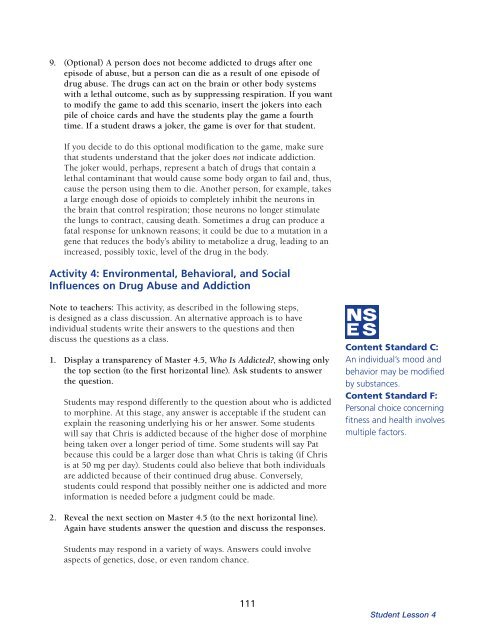Drug Abuse And Addiction - NIH Office of Science Education
Drug Abuse And Addiction - NIH Office of Science Education
Drug Abuse And Addiction - NIH Office of Science Education
You also want an ePaper? Increase the reach of your titles
YUMPU automatically turns print PDFs into web optimized ePapers that Google loves.
9. (Optional) A person does not become addicted to drugs after oneepisode <strong>of</strong> abuse, but a person can die as a result <strong>of</strong> one episode <strong>of</strong>drug abuse. The drugs can act on the brain or other body systemswith a lethal outcome, such as by suppressing respiration. If you wantto modify the game to add this scenario, insert the jokers into eachpile <strong>of</strong> choice cards and have the students play the game a fourthtime. If a student draws a joker, the game is over for that student.If you decide to do this optional modification to the game, make surethat students understand that the joker does not indicate addiction.The joker would, perhaps, represent a batch <strong>of</strong> drugs that contain alethal contami nant that would cause some body organ to fail and, thus,cause the person using them to die. Another person, for example, takesa large enough dose <strong>of</strong> opioids to completely inhibit the neurons inthe brain that control respira tion; those neurons no longer stimulatethe lungs to contract, causing death. Sometimes a drug can produce afatal response for unknown reasons; it could be due to a mutation in agene that reduces the body’s ability to metabolize a drug, leading to anincreased, possibly toxic, level <strong>of</strong> the drug in the body.Activity 4: Environmental, Behavioral, and SocialInfluences on <strong>Drug</strong> <strong>Abuse</strong> and <strong>Addiction</strong>Note to teachers: This activity, as described in the following steps,is designed as a class discussion. An alternative approach is to haveindividual students write their answers to the questions and thendiscuss the questions as a class.1. Display a transparency <strong>of</strong> Master 4.5, Who Is Addicted?, showing onlythe top section (to the first horizontal line). Ask students to answerthe question.Students may respond differently to the question about who is addictedto morphine. At this stage, any answer is acceptable if the student canexplain the reasoning underlying his or her answer. Some studentswill say that Chris is addicted because <strong>of</strong> the higher dose <strong>of</strong> morphinebeing taken over a longer period <strong>of</strong> time. Some students will say Patbecause this could be a larger dose than what Chris is taking (if Chrisis at 50 mg per day). Stu dents could also believe that both individualsare addicted because <strong>of</strong> their continued drug abuse. Conversely,students could respond that possibly neither one is addicted and moreinformation is needed before a judgment could be made.Content Standard C:An individual’s mood andbehavior may be modifiedby substances.Content Standard F:Personal choice concern ingfitness and health involvesmultiple factors.2. Reveal the next section on Master 4.5 (to the next horizontal line).Again have students answer the question and discuss the responses.Students may respond in a variety <strong>of</strong> ways. Answers could involveaspects <strong>of</strong> genetics, dose, or even random chance.111Student Lesson 4
















